Caballero B. (ed.) Encyclopaedia of Food Science, Food Technology and Nutrition. Ten-Volume Set
Подождите немного. Документ загружается.

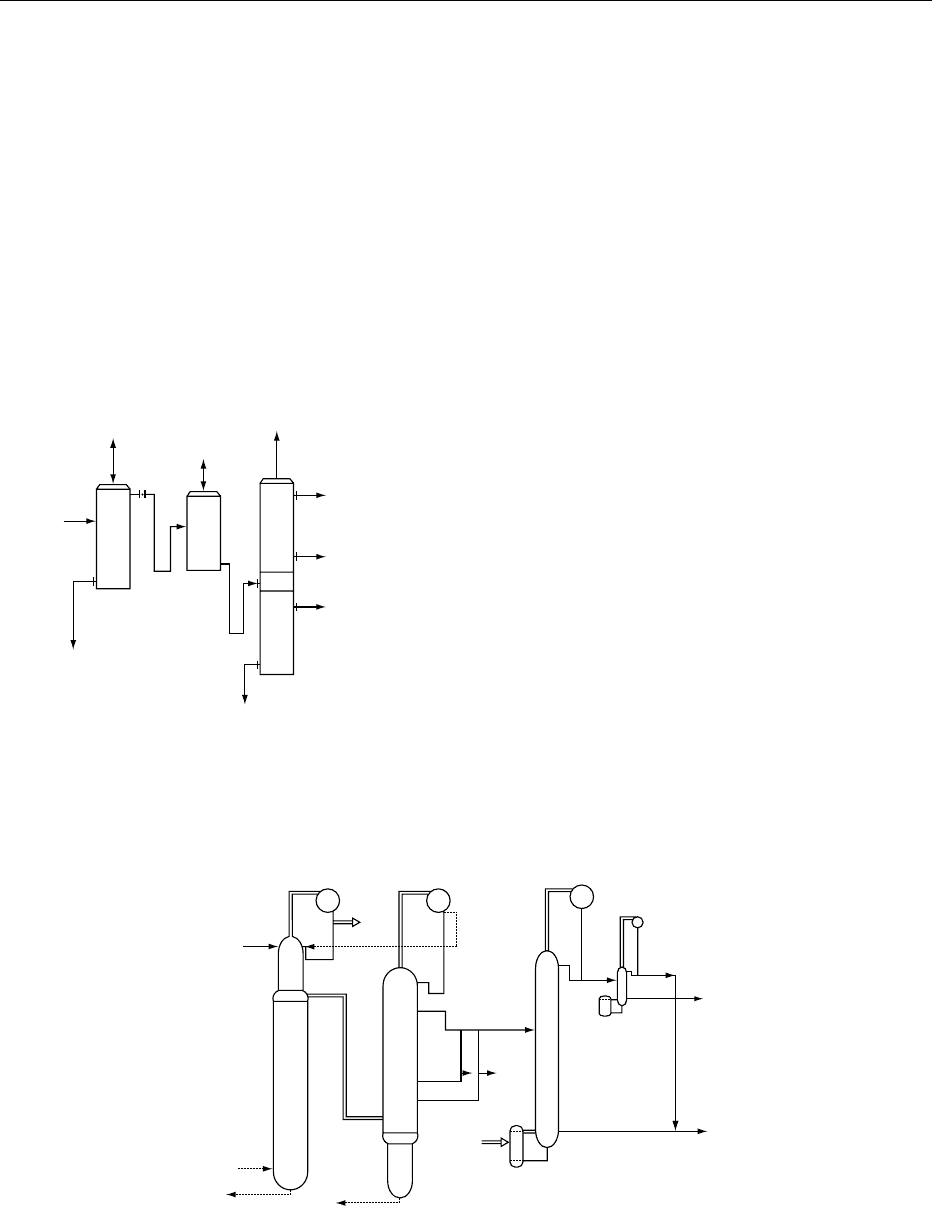
sent into trays but go directly into the continuous
rectifier on the end of the column.
0013 A is the distillation column producing the phlegm;
while hot, phlegm is then extracted from the distilla-
tion column and sent directly to the purifying column
(B) of the continuous phlegm rectifier.
0014 The purifying column extracts the head foreshots,
after which the purified phlegm is sent to the rectify-
ing column (C) from which the drinkable pasteurized
alcohol is drawn off; the unpasteurized alcohol,
which is downgraded, and the low- and high-fusel
oils are also extracted.
0015Special devices have been added to the columns to
recycle the most volatile substances which are of
organoleptic interest (Figure 2).
0016This specific draw-off determines the final amount
of tailings in the distillate.
0017For the subsequent production of wine spirits, only
the higher alcohols are partially eliminated (high- and
low-fusel oils) in order to recompose the distillate as
desired. In this case, the resulting alcohol can only be
called distillate and not ‘spirits’, because of the high
percentage of alcohol – higher than 86% vol. –
required for sorting heavy impurities.
0018Methanol is extracted on a special multiple-plate
column (about 50 plates). This column has the disad-
vantage of eliminating not only the methanol but also
volatile compounds of organoleptic interest; a small
column can be added which separates the methanol
and the volatile substances, and the latter are reintro-
duced into the distillate.
0019Batch rectification for the production of wine spirits
or distillate This kind of still has a boiler similar
to that of the Charente still or of cylindrical boiler
stills. Primary spirits can be slightly oxidized before
redistillation. This batch rectier comprises a steam-
producing device, a 30-plate column, and cooler
satellites and circuits. Head and tail products can be
recycled in the boiler (Figure 3).
Composition of Brandies
0020Because of the nature of the raw material brought
into play (usually red wine) and how they are made,
brandies contain far fewer volatile substances than
Wine
SO
2
HR
WS
HO
D
LO
Corrected wine spirit
Head products
Methanol
E
A
B
C
Water steam
Washy wine
Washy phlegms
fig0002 Figure 2 Continuous wine rectifier with head foreshot recuperation. A, distillation column; B, desulfitation column; C, concentration
column; D, demethanolation column; E, column for the separation of esters from methanol (head products); HR, head product
recycling; LO, low-fusel oils; HO, high-fusel oils; WS, wine spirit. Reproduced from Guigon and Cogat P (1991) Elimination des de
´
fauts
dans les eaux-de-vie de vin traditionelles. In: Les Eaux-de-vie Traditionelles d’’Origine Viticole, pp. 110–113. Paris: Lavoisier-TEC & DOC,
with permission.
Head
foreshots
Head
foreshots
Alcohol to be recycled
Alcohol
High-fusel oils
Low-fusel oils
Washy phlegms
Phlegms
Washy wine
Wine
A
B
C
fig0001 Figure 1 Indirect continuous wine rectifier. A, distillation
column; B, purifying column; C, rectification column. Reproduced
from Mariller C (1925) Distillation et Rectification des Liquides
Industriels. Paris: Dunod, with permission.
BRANDY AND COGNAC/Armagnac, Brandy, and Cognac and their Manufacture 585
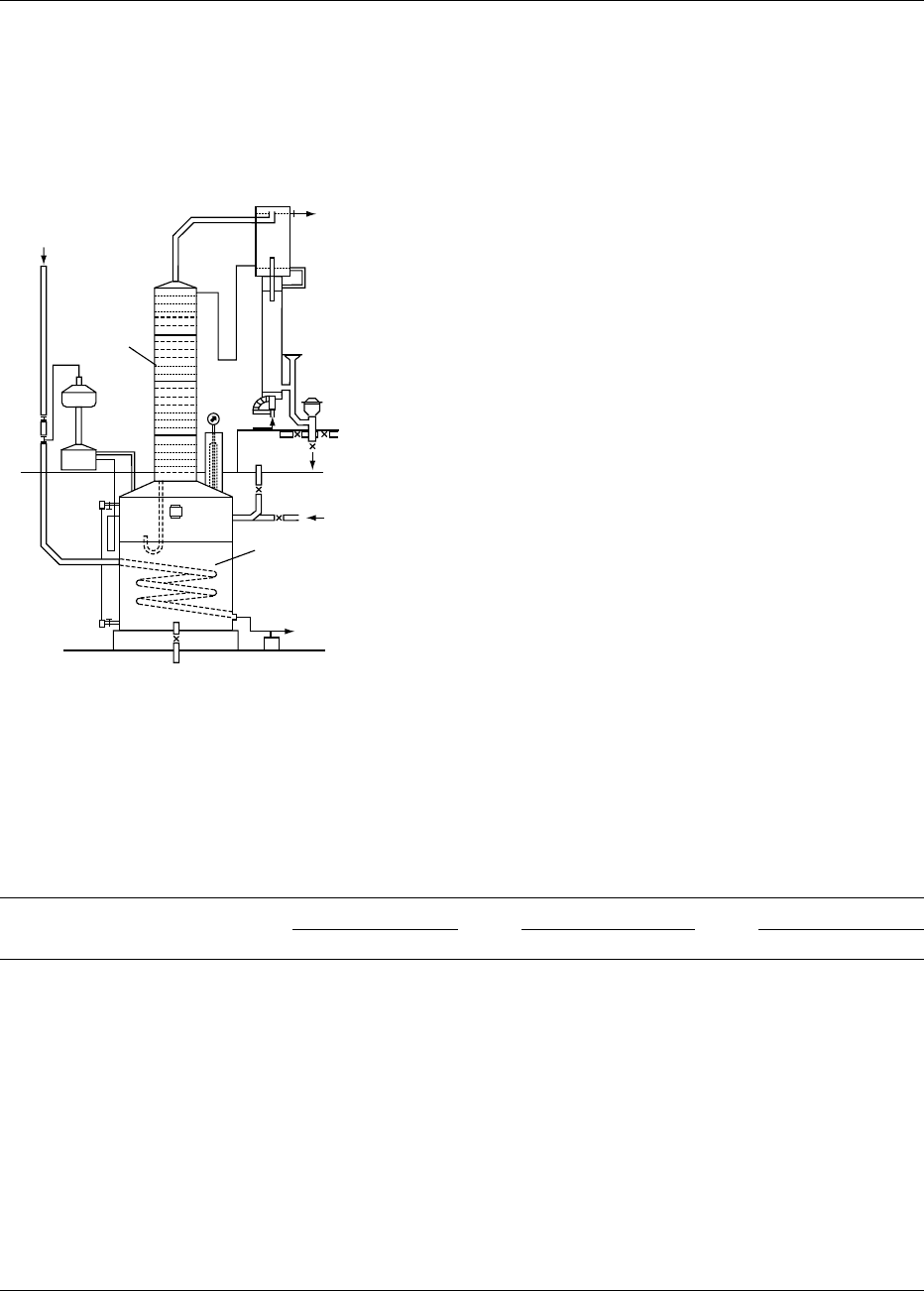
Appellation d’Origine Contro
ˆ
le
´
e (AOC) spirits
(Table 1); higher alcohols are rectified by specific
fusel oil separation processes; head products lose
most of their ethyl acetate and esters during the etha-
nal and sulfur dioxide elimination process.
0021Making brandy is usually a way of salvaging de-
fective wines or production surpluses. However, there
are some good-quality brandies made from wines
which are specially grown for the purpose and
vinified with limited quantities of SO
2
.
0022Gas chromatography is used to analyze volatile
compounds. As an example, the chromatogram in
Figure 4 shows some of the volatile alcohols, esters,
acids, and various aromatic components contained in
an ether-hexane extract of a brandy. Other analyses
can be carried out by injecting the spirits directly
into the chromatograph. The high levels of diethyl
succinate indicate that the wine distilled was older
than the wine used for Cognac and Armagnac.
Aging and Merchandising Preparations
0023As specified in the law, brandies are aged in wood
containers (sous bois); different processing methods
can be used: cold processing, ion exchange resins to
eliminate sulfur dioxide, calcium, and copper cations;
sugar, caramel, and boise
´
(infusions from oak
shavings) may be added. Brandies are reduced with
deionized water and must have a minimum 37.5%
vol alcohometric titer.
0024The entire production of French brandy is
exported.
Summary
0025Wine spirits of viticultural origin belong to French
cultural heritage; they also constitute a major part
of our economy.
0026Furthering our knowledge of their composition
reveals that traditional wine spirits have exactly the
Water steam
Wine spirit
Head foreshots
Tail products
Phlegms
W
C
R
B
A
fig0003 Figure 3 Batch rectifying still for the production of wine spirit
or distillates. A, boiler; B, distillation column (30 plates);
C, condenser; R, refrigerator (cooler); W, water. Reproduced
from Guigon D and Cogat P (1991) Elimination des de
´
fauts dans
les caux-de-vie de vin traditionelles. In: Les Eaux-de-Vie Traditio-
nelles d’Origine Viticole, pp. 110–113. Paris: Lavoisier-TEC & DOC,
with permission.
tbl0001 Table 1 General composition of different wine spirits. Results are given as g hl
1
pure alcohol (100% vol) of an average 15 samples
Armagnac Cognac Brandy
a
Average SD Average SD Average SD
Alcohol strength (% vol) 41.4 1.6 40.04 0.75 45.46 11.1
Dry extract (g l
1
) 4.5 3.5 6.7 3 8.43 1.58
Total acidity (as acetic acid) 153.9 57.6 103.6 28.2 31.46 8.23
Volatile acidity (as acetic acid) 106.5 37.5 59.3 19.3 19.06 3.53
Aldehydes (as ethanal) 23.3 6.4 19.3 8.25 25.33 7.32
Esters (as ethyl acetate) 109.6 34.7 72.9 7.2 54.8 6.72
Among esters, ethyl acetate 78.3 24 45 5.9 38.5 4.2
Furfural 1.2 0.8 2.45 0.93 0.35 0.14
Higher alcohol 441.4 42.3 444.4 127.5 258.4 23.28
Butan-2-ol 0.5 0.85 0.7 1.6 3.39 1.64
Propan-1-ol 49.4 13.5 43 7.8 25.06 2.22
2-Methylpropan-1-ol 104.5 19 121.7 18.8 55.43 5.09
Butan-1-ol 0.2 0.5 0.1 0.3 1.34 0.67
2-Methyl þ3-methylbutan-1-ol 286.6 33.2 312.3 29.6 172.73 20.46
Sum of volatile substances
b
682.1 83.6 632 42.2 357.5 31.36
Methanol 47 10.9 49.7 11.4 69.2 16.5
a
Most brandies are not yet ready for consumption.
b
Ethyl acetate is included with esters.
586 BRANDY AND COGNAC/Armagnac, Brandy, and Cognac and their Manufacture
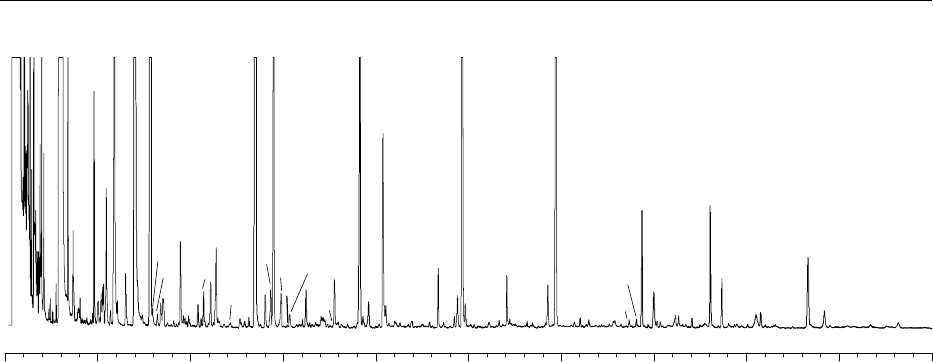
same composition as wine; only the heaviest and most
polarized products are rectified (acetic acid, phenyl
ethanol, polyols).
0027 Major defects can only be eliminated with a distil-
lation column, but at the cost of eliminating compon-
ents which contribute to quality.
0028 Good-quality wine spirits can only be made with
good-quality wines; expensive aging in oak casks
should be reserved for noble products.
Armagnac
Historical Background
0029 According to scholars, Armagnac is the oldest known
wine spirit; it has been produced without interruption
since the early fifteenth century.
0030 The name is the result of successive transform-
ations of the word ‘arminiacum,’ meaning owned by
or estate of Arminius. Arminius may be the latinized
form of Hermann, a Saxon warrior and a companion
of Clovis, the Frank king, who crossed the Rhine in
406 to wage war in the south-west of France. A Count
of Armagnac is recorded in about 1032.
0031 As in many other regions of France, the vineyards
developed considerably under the Romans, until their
expansion was temporarily interrupted by a decree of
Emperor Domicien in 92 (in fact, half of the vines
were pulled up and not planted again until 267, when
Emperor Probus published an edict authorizing
wine growing in Gaul). Vines continued to be planted
all through the barbarian invasions and developed
essentially around the monasteries. A tithe levied by
the monks from the Abbey of Saint Mont (Gers)
testifies that wine was being produced in the tenth
century.
0032In 1254, Bayonne was actively trading with mer-
chants from northern Europe; wines from Chalosse
and probably from the west of Armagnac were
shipped down the Adour. Wines from Haut Armag-
nac passed in transit on their way to Bordeaux, but, in
1241, the Bordeaux authorities decided to regulate,
to their advantage, the Haut-Pays wines arriving in
Bordeaux.
0033For a region so far removed from any natural outlet
to the sea, distillation proved very early to be a rea-
sonable solution, with smaller volumes to transport
and without the quality of the wine deteriorating.
This explains why the Comte
´
of Armagnac became
the first region of France to develop distillation. At
the time, most of Aquitaine was English and wine
growing was certainly favored by the flourishing
trade between England and Northern Europe, as
well as by the pilgrimage to Santiago de Compostela.
min
0 1020304050
Stationary phase
60 70 80 90
1
2
3
4
5
6
7
8
9
10
11
13
14
15
16
19
20
17
18
21
22
23
24
25
26
27
28
29
30
31
32
33
34, 35
36
37
38
39
40
41
42
43
44
45
46
47
48
49
50
51
52
53
54
55
fig0004 Figure 4 Chromatogram of the extract of a brandy by ether hexane (concentration about three times); column FFAP 50 m 0.22 mm;
injection by splitless mode; temperature programming from 40 to 200
C. Identification of the peaks: 1, Ethyl butyrate; 2, 2-methylpro-
pan-1-ol; 3, isoamyl acetate; 4, isoamyl alcohols; 5, ethyl hexanoate; 6, hexyl acetate; 7, styrene; 8, acetoin; 9, ethyl heptanoate; 10,
ethyl lactate; 11, hexan-1-ol; 12, trans-hex-3-en-1-ol; 13, cis-hex-3-en-1-ol; 14, octan-3-ol (internal standard 1); 15, trans-hex-2-en-1-ol;
16, ethyl octanoate; 17, trans-linalol oxide (furane); 18, cis-linalol oxide (furane), 19, acetic acid; 20, benzaldehyde; 21, linalol; 22,
2-methylpropionic acid; 23, ethyl decanoate; 24, butyric acid; 25, 3-methylbutyric acid; 26, diethyl succinate; 27, a-terpineol; 28,
1,1,6-trimethyl-1,2-dihydronaphthalene (TDN); 29, methionol; 30, unknown; 31, unknown; 32, damascenone; 33, phenylethyl acetate;
34, ethyl dodecanoate; 35, hexanoic acid; 36, benzyl alcohol; 37, 2-phenylethanol; 38, heptanoic acid; 39, 4-ethylgaiacol; 40, ethyl
myristate; 41, octanoic acid; 42, 4-allylgaiacol (eugenol); 43, 4-ethylphenol; 44, ethyl palmitate; 45, decanoic acid; 46, ethyl stearate; 47,
ethyl oleate; 48, dodecanoic acid; 49, ethyl linoleate; 50, ethyl linolenate; 51, unknown; 52, myristic acid; 53, palmitic acid; 54,
palmitoleic; 55, linoleic acid.
BRANDY AND COGNAC/Armagnac, Brandy, and Cognac and their Manufacture 587
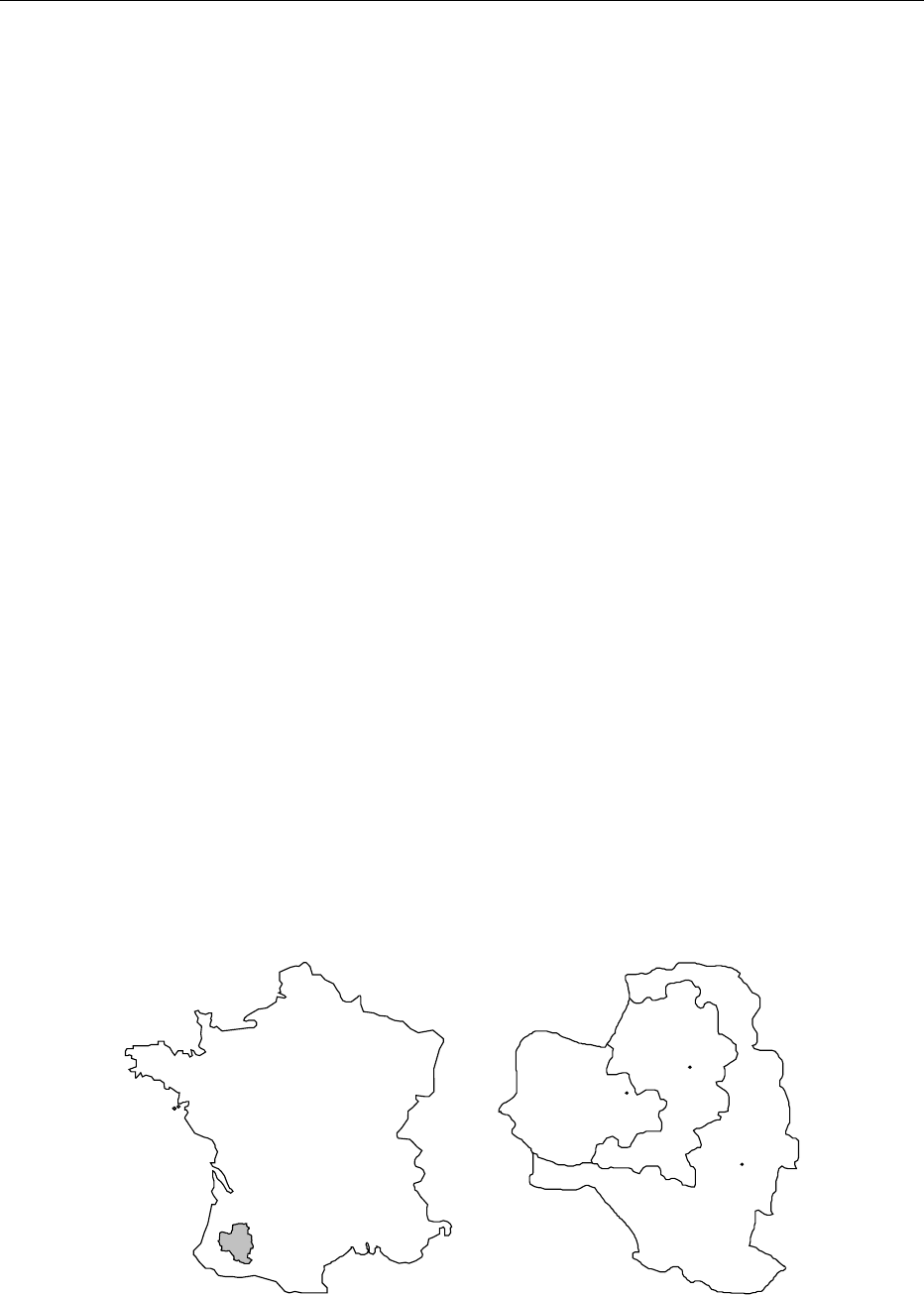
0034 In 1411, the archives of the Haute-Garonne show
that a distiller, M Antoine (aygua ardentarius), was
producing a wine spirit, ‘aygue de Bito,’ in Toulouse;
28 years later, in 1439, the same source mentions
other distillers: Jean Nouvel and his wife ‘facientes
aquam ardentum.’ One document, dated 1461, men-
tions the levy of taxes, which testifies to the beginning
of an Armagnac trade in Saint-Sever (Landes). In
1489, a document in the Gers archives mentions the
presence of a still in Solomiac (Gers). By 1550, both
Bordeaux and Bayonne were selling Armagnac to
northern Europe.
0035 Until the eighteenth century, wines were distilled in
pot stills; these were simple devices similar to those
described by Savonarole in 1440 in his treaty on
distillation, ‘Confidencia aquae vitae,’ in which he
describes the first copper still with a coil plunged in
cold water. It was only toward the mid eighteenth
century that distillation methods began to be im-
proved. In 1761, with the help and advice of the
chemist Chaptal, Menier invented a new process
known as continuous distillation, and this process
was patented by Adam in 1801.
0036 This new distillation technique rapidly spread to
the whole Armagnac area and is still the method used
today, with few alterations. However, the type of still
used in Charentes had to gain formal approval again
in 1972.
0037 The French Revolution boosted production:
50 000 hl of pure alcohol were produced in 1810,
and over 100 000 hl in 1873, corresponding to
107 000 ha of vines. At that time, the Armagnac vine-
yard was one of the largest in France but in 1879 it
was hit by phylloxera; 10 years later, alcohol produc-
tion had been reduced by two-thirds. The vineyard
was never to be entirely replanted and present-day
production wavers between 20 000 and 50 000 hl
per year as pure alcohol.
Appellation Areas, Soils, Climate, Vine stocks
0038The region of production covers about 12 000 ha,
divided into three areas: Bas-Armagnac, Te
´
nare
`
ze,
and Haut Armagnac (Figure 5).
0039Bas-Armagnac Bas-Armagnac is the most product-
ive area – about 60% of the vineyard – with acid,
predominantly sandy soils. Conversely, the soil in
Haut-Armagnac is mainly composed of calcareous
clay and has virtually ceased producing wine spirits.
A blend of wine spirits from several minor appella-
tions can only be called plain Armagnac.
0040Bas-Armagnac is a flat area, on the edge of the
Landes forest, and the slightly acid, siliceous clay
soil often contains iron oxides which endow it with
a dark color – hence the name ‘fawn sands.’
0041The annual mean temperature is 13
C, with 7.5
C
in winter and 20
C during the three summer months.
Annual rainfall is 892 mm. The rain is well spread out
over the year, with 1 mm minimum in July and 86 mm
maximum in May.
0042Te´nare`ze The hilly landscape of the Te
´
nare
`
ze area
consists of a variety of soils: sand, outcrops of calcar-
eous clay, and boulbe
`
nes (a mixture of clay and fine
sand) in the valleys. Being further away from the
ocean, and especially from the Landes forest, the
climate is a little more ‘continental,’ entailing atmos-
pheric disturbances and more rainfall.
0043Mean annual rainfall is 804 mm, the main differ-
ence from Bas-Armagnac being the frequent thunder-
storms in October.
BAS ARMAGNAC
TENAREZE
HAUT
ARMAGNAC
EAUZE
AUCH
CONDOM
fig0005 Figure 5 Armagnac in France and the three appellation areas.
588 BRANDY AND COGNAC/Armagnac, Brandy, and Cognac and their Manufacture

0044 Likewise, temperatures range between 7.2
Cin
winter and 26
C in summer. This difference is due
to wind conditions; the area is still exposed to the east
wind (vent d’Autan), which brings the end of summer
droughts and storms.
0045 Haut-Armagnac In Haut-Armagnac, soils are more
calcareous and the climatic differences even more
pronounced. The average period of sunshine in
Auch is 1934 h, surprisingly, this is 5% less than in
Bordeaux, perhaps because of a longer period of
cloud cover.
0046 The main different vine stocks allowed are Ugni
blanc, Baco 22 A, Folle Blanche and Colombard.
0047 Ugni blanc, an Italian vine stock related to Treb-
biano, is rapidly gaining ground, as it offers the
advantage of coming to maturity in the ‘troisie
`
me
e
´
poque’ (45 days after Chasselas maturation), thus
eliminating the problem of rot, and it produces low-
alcohol wines suitable for distillation. Baco 22 A,
which ranks second for making Armagnac, is a hybrid
of Noah (Vitis labrusca V. riparia) and Folle
Blanche; it matures 30 days or more after Chasselas
(‘maturite
´
de deuxie
`
me e
´
poque’), is very disease-
hardy and does not require grafting thanks to the
sandy soil of the Landes. This variety stands out as
an exception among the vine stocks used for French
AOCs. The Institut National des Appellations
d’Origine des Vins et Eaux-de-Vie (INAO: French
National Institute for Wine and Spirits Appellations
of Origin) is planning to eliminate it from the Armag-
nac vineyard by 2010. The rather ‘foxy’ flavor of
Baco wines, due to the presence of furaneol and me-
thylic anthranilate (‘labrusca’ character), disappears
during distillation and neither substance is detectable
in the spirits.
0048 The vineyards are of average size; pruning is man-
aged according to the Guyot method in one or two
stages; the vines are trellised and there are 4000–5000
vines per hectare.
Vinification
0049 Most vinegrowers use a grape harvester to harvest the
grapes and a continuous wine press to extract the
juice; such methods, which are usually too brutal for
immature grapes, have no particular drawbacks in
this case as long as the dregs are not strained too
much.
0050 The temperature of alcoholic fermentation is rarely
checked. Wines are not subjected to any enological
process, and sulfur dioxide is strictly forbidden
(Decree of 6 August 1936, modified 24 May 1956).
The alcohol strength of the wine varies considerably,
ranging between 8 and 11.5% vol or more; acidity is
average (4–6.5 g l
1
, expressed as H
2
SO
4
). Malolactic
fermentation usually occurs spontaneously just after
alcoholic fermentation.
0051According to the Bureau Interprofessionnel de
l’Armagnac (BNIA: French Interprofessional Office
for Armagnac), 60 922 hl of pure alcohol were dis-
tilled in 1990, from 567 000 hl of wine. Production
this year has been particularly good. The average
annual production is about 20 000 hl 100% vol
alcohol.
0052By law, wines have to be analyzed in an appointed
laboratory to prove they are free of sulfur dioxide and
of sufficient quality to be used to make Armagnac.
Distillation and Regulations
0053Wines have to be distilled in the appellation area.
Two sorts of stills are used; the BNIA has listed the
following ones which are in use:
1.
0054112 continuous stills: Armagnacais
2.
005512 pot stills, producing less than 10% of the total
volume of Armagnac.
0056The maximum distillation alcohometric titer
allowed is 72% vol, the same as other French AOC
wine spirits (Decree of 6 August 1936). The minimum
alcohometric titer for white spirits (when they come
out of the still) is set at 52% vol.
0057Wines are required to be distilled between the end
of the harvest and 31 March of the following year
(Decree of 15 March 1988, modified).
0058The continuous Armagnac still (Figure 6) The con-
tinuous still used in Armagnac is made entirely of
annealed electrical-grade copper; it works very
much like steam-powered distillation and plays an
essential role in the specificity of armagnac.
0059The boilers, distillation columns, wine-heater, and
cooler constitute the still’s main parts.
0060The volume of the boiler ranges from 5 hl to a
maximum of 35 hl; it is divided into two or three
sections by separation plates. The total capacity of
the boilers must be at least equal to that of the cooling
unit, including the wine-heater and the cooler.
0061The column has five to 15 plates (the most recent
stills have about 12 plates). These plates are fitted
with different-shape bubble-through devices: bubble
caps, bell-shaped tunnels or oil grooves. The plates
above the wine arrival pipe are called dry plates and
help reduce tailings while increasing the alcohometric
titer.
0062The wine-heater is used to preheat the wine; the
coil inside raises the temperature to 70 or 85
C,
which condenses the alcoholic vapors issuing from
the column. The capacity of the wine-heater varies
considerably (5–15 hl).
BRANDY AND COGNAC/Armagnac, Brandy, and Cognac and their Manufacture 589
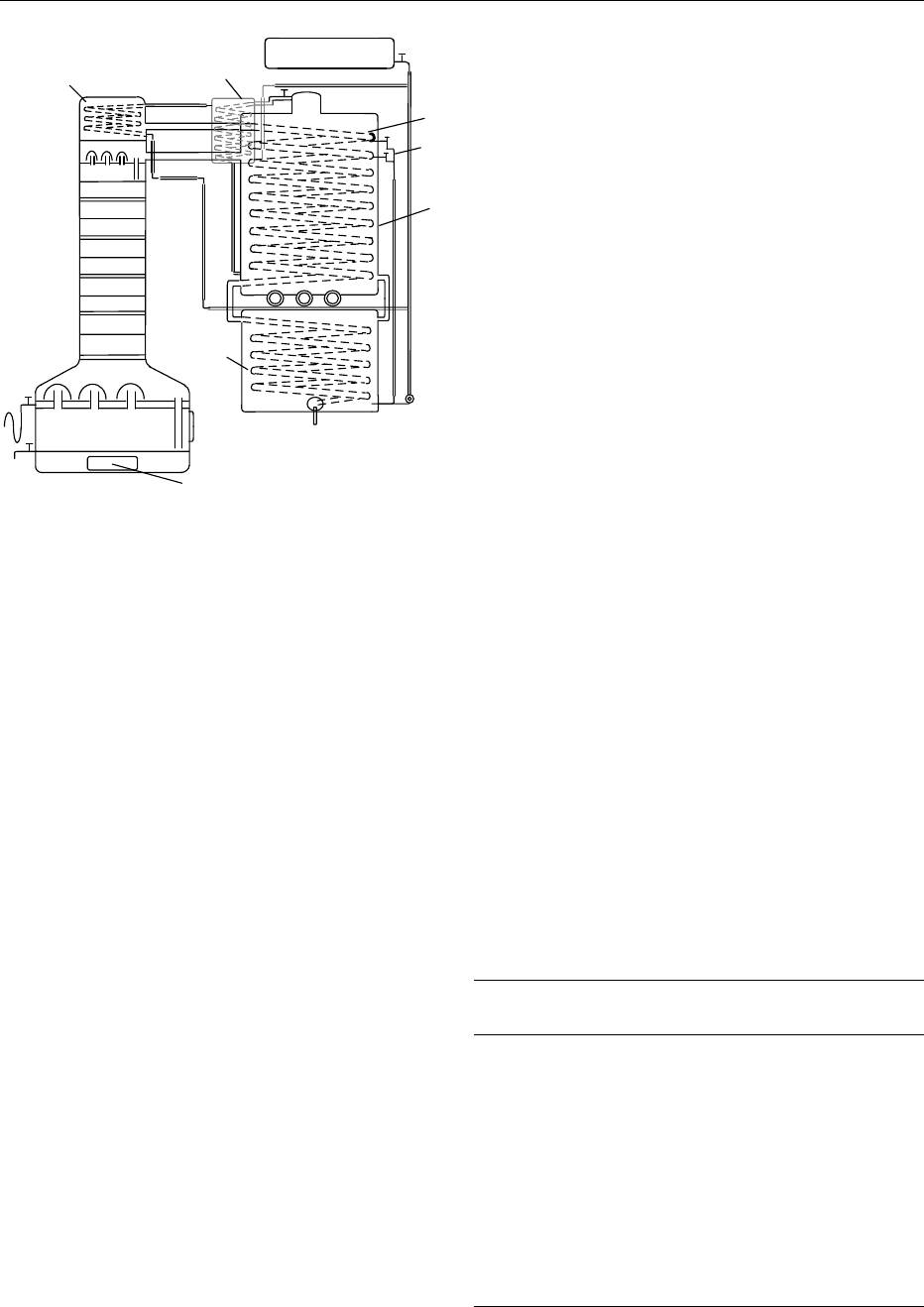
0063 The cooler, which is generally smaller (3–10 hl)
than the wine-heater, is placed under the wine-heater.
After going through the wine-heater, the coil goes into
the cooler to achieve complete condensation and
cooling of alcoholic vapors.
0064 Sometimes, a head foreshot condenser system can
be fitted to the still, above the wine-heater; more
frequently, a tail product condenser is placed level
with the alcoholic vapor pipe, between the column
and the wine-heater. Tailings can also be collected in
the first turns of the coil. The condensed fractions can
be returned to the wine and recycled. A coil can be
added to the head of the column, to circulate pre-
heated wine in the head or tailings condensers; this
also helps to condense the least volatile products and
to increase the percentage of alcohol.
0065 The wine from the loading vat goes into the still,
at the bottom of the cooler, by force of gravity. The
flow is regulated with a gate-valve equipped with a
flowmeter. The spirits come out of the still through
the alcohometer holder where the temperature and
alcohometric titer of the distillate are measured.
Washy wines are evacuated continuously through a
syphon connected to the boiler.
0066 The daily quantity produced cannot exceed one
and a half times the capacity of the whole cooling
system.
0067The wine is always heated over an open fire, usu-
ally propane gas, although wood is still frequently
used to heat small stills.
0068Because of the way it works, Armagnac distillation
is not only far more economical than two-stage distil-
lation, but also three times as fast.
0069When it has been running for about 2 weeks, the
still is turned off and cleaned. Sediments accumulated
on the plates and residues prevent the copper from
fixing the volatile acids and sulfurous compounds.
Inadequate cleaning soon results in the appearance
of an unpleasant flavor and a greasy rancid smell, like
seconds.
0070To start the still, one proceeds as follows: first, the
boiler and the column are filled with water; once the
wine-heater and the cooler are full of wine, the fire is
lit; when the water begins to distill, the wine inlet pipe
is opened. As soon as the desired alcohometric titer
is reached (60% vol, for instance), the spirits are
recuperated.
0071With the Armagnac distillation method, the vola-
tile substances are either entirely distilled (higher
alcohols), or are more or less rectified (2-phenyl etha-
nol, ethyl lactate, 2,3-butanediol), according to their
polarity. The fatty acid ethyl esters and fatty acids
with a high molar weight are released by heating the
yeasts, which means that the quantity of these acids
depends on the the wine’s yeast content; generally
speaking, there are about four times fewer fatty acid
ethyl esters with 8, 10, and 12 atoms of carbon in
Armagnac than in Cognac. This leads connaisseurs to
claim that the quality of Armagnac comes from the
specific nature of its soils and the aromas of vines
harvested at maturity and not only from their yeast
ester content (Table 2).
M
A
B
J
D
E
F
G
H
I
C
K
L
A: Head of wine, B: cooler, C: wine heater, D: head condenser,
E: wine arrival, F: column, G: boilers, H: head of column,
I: swan neck, J: coil, K: drawing and recycling of tailings
L: alcohometer holder, M: furnace.
fig0006 Figure 6 Armagnac still.
tbl0002Table 2 Distillation of volatile substances (average from 50
wines and their corresponding spirits)
Wine
(mgl
1
)
Spirit
(mgl
1
)
% Recovery
Ethanol, (% vol) 11.1 59.7
Higher alcohols 373 2043 102
Methanol 41.4 194 87
2-Phenyl ethanol 53 32 10
Higher alcohol acetates 2.61 12.7 90
Volatile acid ethyl esters 1.46 14 177
Ethyl acetate 41 207 94
Diacetyl 0.65 2.91 83
Volatile acids (C3 – iC5) 4.12 10.79 38
Volatile acids (C6 – C12) 11.2 34.2 56
Ethyl lactate 340 248 14
Acetic acid 400 118 5.5
Butane-2,3-diol 549 14.9 0.5
590 BRANDY AND COGNAC/Armagnac, Brandy, and Cognac and their Manufacture
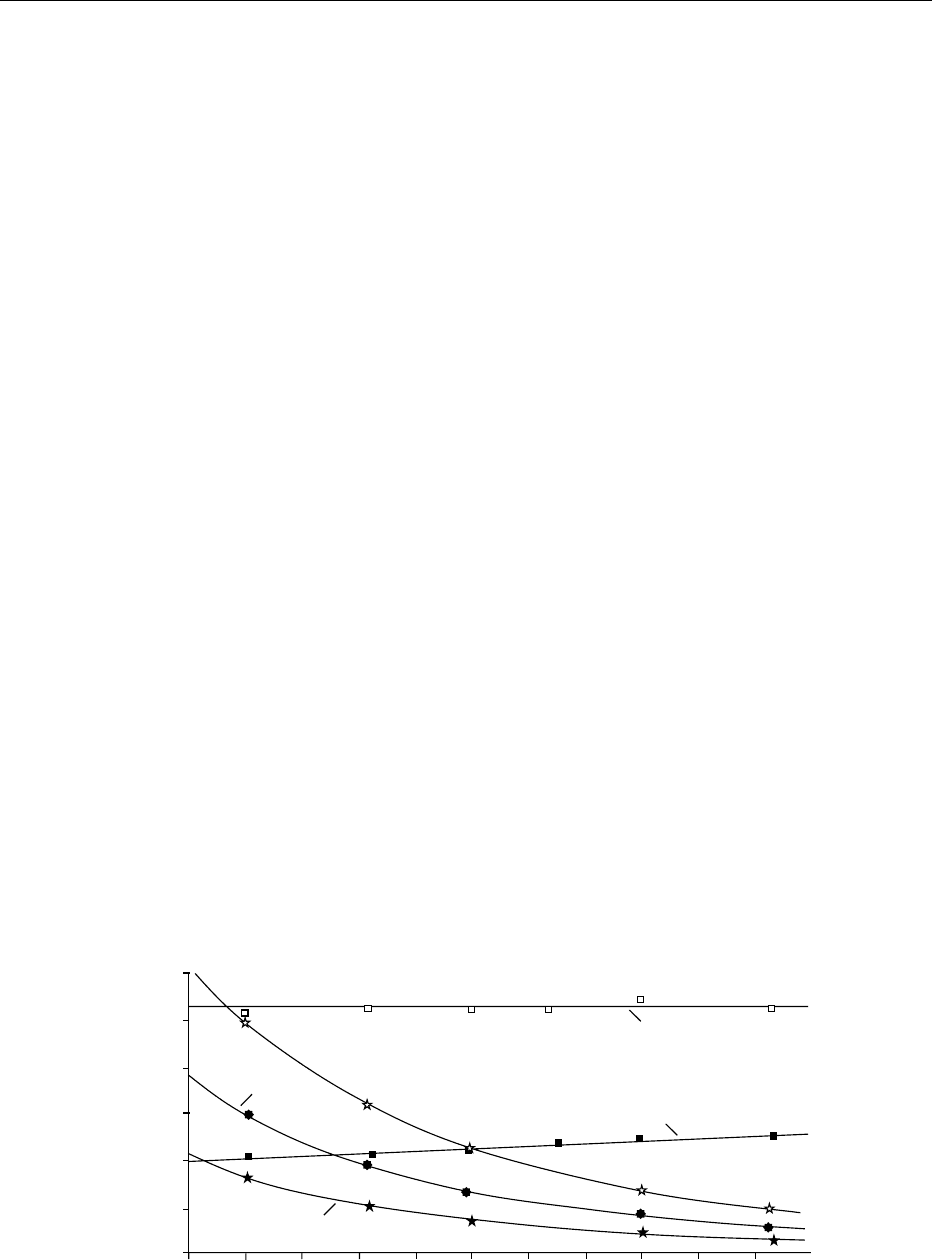
0072 To modify the composition of the spirits, the distil-
ler mainly controls two parameters: wine flow and
heating.
0073 How the still is adjusted plays an essential role in
the composition of the spirits: lowering the heating or
increasing the wine flow brings down the temperature
at the head of the column and results in a higher
alcohometric titer; in this case higher alcohol and
ester concentrations correspond exactly to the per-
centage of alcohol, in other words, the quantity of
these substances expressed in g hl
1
remains constant
(Figure 7).
0074 Conversely, the amount of substances called tail-
ings, of which there is usually a surplus in Armagnac,
decreases exponentially when the percentage of
alcohol increases. For prolonged aging, a large quan-
tity of tailings is an advantage because of the ‘winey’
character of their molecules; but if the Armagnac is
to be marketed soon, it is preferable to make a
high-proof distillate to limit the amount of such
substances.
0075 Two-stage pot stills These stills are used in the same
way as for Cognac; however, in Armagnac, sediments
are never reintroduced in suspension into the wine
before distillation. Two-stage distillation has its ad-
vantages: the Armagnac ages more quickly and can
thus be marketed much earlier, although it loses some
of its specificity in the process.
Analysis
0076 Two sorts of analysis are carried out on wine-spirits:
(1) traditional analyses; and (2) analyses to improve
knowledge of the products and establish correl-
ations between their chemistry and organoleptic
observations.
0077Traditional analyses Their purpose is to determine
real and raw volume-percentages of alcohol (titra-
tion), dry extract, total acidity, and the ratio of non-
alcoholic elements, i.e., volatile acidity, aldehydes,
esters, furfural, and higher alcohols; methanol values
are determined separately.
0078Table 1 shows mean values for Armagnac and
Cognac, compared to brandy. The sum of volatile
substances of brandy is noticeably lower than the
others; this is due to the fact that it is elaborated in
columns.
0079Conversely, brandy contains more methanol than
Armagnac or Cognac, because it is made essentially
with red wines.
0080Gas chromatography Gas chromatography is used
to analyze volatile compounds. As an example, the
chromatogram in Figure 8 shows some of the volatile
alcohols, esters, acids, and various aromatic compon-
ents contained in an ether-hexane extract of Very
Special Old Pale (VSOP) Armagnac. Other analyses
can be carried out by injecting the spirits directly into
the chromatograph. The high levels of butanediol
found in Armagnac show that it is rich in tail
products.
0081A set of average values can be established from
these analyses (Table 1).
0082Carbonyl compounds are currently being analyzed;
long-chain aldehydes seem to be specific to Armag-
nac; methyl ketones, glyoxal, and methyl glyoxal
levels increase with age. These carbonyl compounds
contribute to the rancid character of old wine-spirits.
0083Different high-performance liquid chromatog-
raphy (HPLC) analyses can also be carried out by
absorption spectroscopy to measure the principal
phenolic compounds extracted from wood which
contribute to the vanilla flavor that develops with age.
Σ Higher alcohols
Σ Esters x 100
Butanediol x 40
Ethyl lactate
Phe-ethanol x 40
50 54 5652 58 60 62 6664 68 70
0
400
300
200
100
500
600
Volatile substances (mg/L)
Alcoholic strength of distillation (%vol.)
fig0007 Figure 7 Relationship between alcoholic strength of distillation and content of volatile substances.
BRANDY AND COGNAC/Armagnac, Brandy, and Cognac and their Manufacture 591
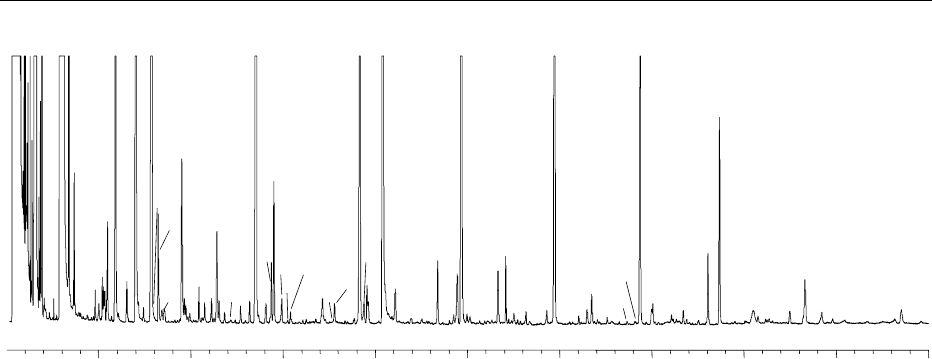
0084 Sensory analyses Sensory analyses can also be
carried out by experienced wine-tasters. Tasters fill
in a multiple-choice question tasting-card, and tick
off the boxes corresponding to their perceptions;
there are also questions related to ‘hedonistic’ sensa-
tions. Since Armagnac comprises several hundreds of
substances, it is extremely difficult to describe it ac-
curately in just 20 questions (which is a maximum),
but no other solution is forthcoming. Results are
often computer-processed using multidimensional
analysis methods; multiple correspondence factorial
analysis is the best suited.
0085 The main features of old Armagnac are its aroma of
prunes, its ‘rancio’ taste, its complexity; it is vigorous
and even rough, with a long-lasting palate.
Aging and Merchandising Preparations
0086 Wine spirits are usually aged in oak casks. Coarse-
grained wood is preferred (Gascony or Limousin) to
fine-grained wood, as it is slightly more permeable
to oxygen and yields more tannin.
0087 At this stage, oxidation is of prime importance, not
only for the development of the substances originat-
ing from the wood, but also for the distillate itself.
Alcohol is oxidized into acetic acid, the quantity of
which increases threefold in 20 years; pH, which is 5
in a young wine spirit, drops to 3.5; acids in turn
partially become esters; and, in the end, only the
higher alcohols remain relatively unchanged in rela-
tion to ethanol.
0088Oak consists of 40–45% cellulose, 20–25% hemi-
cellulose, 25–30% lignin, and 8–15% tannins. The
optimal alcohometric titer to extract these compon-
ents with wine spirits is around 55% vol. Armagnac
just out of the still lends itself perfectly to harmonious
aging.
0089The amount of substances extracted from the wood
depends on whether the cask is new or old; over a 12-
year period, a new cask can produce three times as
much as an old one.
0090Spirits with too much tannin (castalagin and vesca-
lagin) can be harsh and astringent.
0091With time, lignin is transformed into aromatic al-
dehydes and phenolic acids.
0092Armagnac contains vanillin, syringaldehyde, con-
iferaldehyde, and sinapaldehyde, but only the vanillin
is detectable at tasting.
0093Although there are a variety of aging methods,
spirits are usually kept in new casks for 6 months to
1 year before being transferred to old casks.
0094Prior to being marketed, several wine spirits are
blended and the alcohometric titer of the blend
(the cut) is reduced to a minimum of 40% vol with
distilled water. The naturally golden-yellow color can
be enhanced with caramel. Sometimes, infusions or
decoctions made from oak shavings are added to
min
0
10 20 30 40 50 60 70 80 90
1
2
3
4
5
6
7
8
9
10
11
13
14
15
16
19
20
17
18
21
22
23
24
25
26
27
28
29
30
31
32
33
34
36
37
38
39
40
41
42
43
44
45
46
47
48
49
50
51
52
53
54
55
35
fig0008 Figure 8 Chromatogram of the extract of an Armagnac by ether hexane (concentration about 3 times); column FFAP 50 m 0.22 mm;
injection according to splitless mode; temperature programmation from 40 to 200
C. Identification of the peaks: 1, Ethylbutyrate; 2,
2-methylpropan-1-ol; 3, isoamyl acetate; 4, isoamyl alcohols; 5, ethyl hexanoate; 6, hexyl acetate; 7, styrene; 8, acetoin; 9, ethyl
heptanoate; 10, ethyl lactate; 11, hexan-1-ol; 12, trans-hex-3-en-1-ol; 13, cis-hex-3-en-1-ol; 14, octan-3-ol (internal standard 1); 15, trans-
hex-2-en-1-ol; 16, ethyl octanoate; 17, trans-linalol oxide (furane); 18, cis-linalol oxide (furane), 19, acetic acid; 20, benzaldehyde; 21,
linalol; 22, 2-methylpropionic acid; 23, ethyl decanoate; 24, butyric acid; 25, 3-methylbutyric acid; 26, diethyl succinate; 27, a-terpineol;
28, 1,1,6-trimethyl-l,2-dihydronaphtalene (TDN); 29, methionol; 30, inconnu; 31, inconnu; 32, damascenone; 33, phenylethyl acetate; 34,
ethyl dodecanoate þhexanoic acid; 35, benzyl alcohol; 36, trans-whisky lactone; 37, 2-phenylethanol; 38; cis-whisky lactone; 39, 4-
ethylgaiacol; 40, ethyl myristate; 41, octanoic acid; 42, 4-allylgaiacol (eugenol); 43, 4-ethylphenol; 44, ethyl palmitate; 45, decanoic acid;
46, ethyl stearate; 47, ethyl oleate; 48, dodecanoic acid; 49, ethyl linoleate; 50, ethyl linolenate; 51, inconnu; 52, myristic acid; 53,
palmitic acid; 54, palmitoleic; 55, linoleic acid.
592 BRANDY AND COGNAC/Armagnac, Brandy, and Cognac and their Manufacture

make the Armagnac more astringent, to give it more
body; however, these preparations must be at least the
same age as the youngest spirit used for the commer-
cial designation of the final product. Sugar solutions
are sometimes added to attenuate the ‘burn’ of the
alcohol (about 6 g l
1
).
0095 Finally, before being bottled, the spirits are cold-
processed (usually 1 week at 5
C) and passed
through a cellulose filter to eliminate any possible
cloudiness due to an excess of calcium or fatty acids.
0096 Vintage spirits from a single harvest of a particular
year are sometimes sold with no prior reduction of
their natural alcohometric titer. Vintage Armagnacs
constitute an exception among wine spirits; some of
them are extremely valued and fetch high prices.
0097 The various commercial designations are based on
the youngest spirit in the blend (cut) the BNIA keeps
updated registers listing the age (compte d’a
ˆ
ge) and
volume of all the different Armagnacs stored in any
given storehouse (Table 3).
Cognac
0098 The first distillation of wine for the production of
Cognac took place in Charente in 1622. In fact it
was in the province of Aunis that this distillation
took place, but historically the development of the
vine in this area of the south-west of France is related
to the economic development of the old maritime
province of Saintonge. This was much vaster and
extended from the Se
`
vre Niortaise to Angoule
`
me,
the north of the Dordogne, and the Gironde river.
But, it only really developed from 276 ad with the
edict of the Roman emperor Probus who granted the
privilege of cultivating the vine which had hitherto
been granted only to Romans in 92 ad.
0099 During the thirteenth century trade flourished, in
particular with the shippers of the Nordic countries
who came to buy not only the salt of the Saintonge
salt-pan created by the Romans but also the wine of
Ritsel (La Rochelle) and Saint Jean (d’Ange
´
ly). Since
demand perpetually increased, the wine of the ‘haut
pays’ began to be traded as the small coastal rivers
were navigable (Boutonne river which goes to Saint
Jean d’Ange
´
ly and especially the Charente river,
navigable up to Saintes, Cognac, Jarnac, and Angou-
leme). Dutch sales representatives settled in Tonnay-
Charente, then in Cognac, which was a ‘tax stage’ city
between the provinces of Saintonge and Angoumois
and which in the fifteenth century had an adminis-
trative infrastructure appreciated by the traders.
0100Another important event was the marriage of
Eleanor of Aquitaine with Henri Plantagenet in
1152. This opened up an era of great prosperity for
this province which could practise the trade of wine
since it was now attached to England. The province
then began to plant vines massively. At the end of
the sixteenth century, when the Dutch became the
masters of maritime trade, brandy gradually replaced
wine and it was also used as a currency of exchange
for spices, metals, and slaves. The Dutch stimulated
the production of aquavits and brandevins which
insured a perfect conservation of the distilled product
and made it possible to reduce the volume to be
transported. However, because of the proximity of
the sea, the Dutch could distil the wine on their
premises because the trip was not too long. This
explains the relatively late appearance of distilla-
tion in Saintonge (two centuries later than in
Armagnac).
0101At the beginning the stills were imported from
Holland. They were manufactured with Swedish
copper but the production of stills in Bordeaux and
then in the Cognac area began about 1724. At that
time there occurred a kind of wine revolution which
led certain areas to increase their production, in order
to have the greatest volume for the Dutch merchants.
On the other hand, other areas preferred the produc-
tion of high quality, thereby implying limited yields.
Such was the case in particular for the wines of
Bordeaux, Burgundy, Champagne, for the liqueur
wines of Sauternes, Bergerac, and Borderies (area to
the north-west of Cognac), and finally for Cognac
brandies.
0102In fact, it seems that tax reasons encouraged the
middle-class rich of the city of London to search for
top-of-the-range products. Since taxation of wines
and alcohols was very high from 1628, it was neces-
sary to pay high prices, so the product had to be of
excellent quality. By storing brandy in wood barrels,
the English to some extent invented the aging that is
now known to transform brandies into delicious,
much more agreeable products for consumption.
Moreover, the term ‘Old Cognac Brandies’ appeared
in London in 1700. With the Augier family in 1943,
the British, for example, Jean Martell (1715) and
Richard Hennessy (1765), were partly responsible
for setting up the true commercial structures which
still remain today.
tbl0003 Table 3 Major commercial designations of Appellation
d’Origine Contro
ˆ
le
´
e (AOC) wine spirits
Category Minimum age
(compte d’Jge)
Average age
Three Stars 2 About 2 years
VO, VSOP 4 5 years
XO, Extra, Napoleon 5 6 years
Vieille Re
´
serve, Hors d’Age
VO, Very Old; VSOP, Very Special Old Pale; XO, extra old.
BRANDY AND COGNAC/Armagnac, Brandy, and Cognac and their Manufacture 593

0103 At that time, the trade in wines and brandies was of
equal importance but thereafter, brandy production
really came to the fore.
0104 The production of Cognac began on the chalky
slopes located to the south-east of Cognac, an
area called ‘Champagne’ because of the nature of
the grounds. The vineyards extended gradually to
the surrounding wooded regions. Starting from
15 000 ha in 1600, the vineyard reached 100 000 ha
in 1800 and 255 000 ha in 1878, just before the
phylloxera epidemic which destroyed the Charentais
vineyard.
0105 Nevertheless, the multiple obstacles to trade of all
types, in particular the wars, resulted in huge volumes
of spirit being stored. In 1873 this was evaluated at
7 277 000 hl of Cognac. This made it possible to over-
come the period of reorganization of the vineyard
without losing important customers, in particular
the English.
0106 The Viala mission (1887) found an American vine
in Texas, Vitis berlandieri, which was resistant to
phylloxera and adaptable to the charentais soils
which are very rich in limestone. This made it possible
to create rootstocks which were not susceptible to
chlorosis (when the leaves cannot synthesize chloro-
phyl owing to iron deficiency). Under the control of
Alexis Millardet, the father of the bouillie bordelaise
(copper sulfate þlime) used for treatment against
mildew, research led to the 41 B rootstock, a hybrid
of chasselas and V. berlandieri. This rootstock was
used to reconstitute the vineyard, and gradually the
old traditional type of vines like folle blanche or
Colombard were replaced by the better-adapted
white Ugni blanc cultivar. The average quality of
brandies from Ugni blanc is higher than that of folle
blanche brandies from the last century because the
latter was subject to gray rot.
The Vineyard
0107 Double Guyot pruning of the vine is practiced. Now-
adays, the plants are 1 m 30 on the rows and 3 m
between the rows. Pruning is done with two long
branches arched downwards. The number of buds is
50 000–60 000 per hectare, i.e., 20–22 buds per foot.
Normally the vine is trellised with five or six wires.
0108 Blossoming (de
´
bourrement) of the buds take place
between the end of March and beginning of April,
flowering is about June 20–25, ripening (veraison)
between August 25 and September 10, and harvesting
generally begins about October 10.
The Climate
0109 The climate is moderate and wet, rather similar to
that of Bordeaux, with average temperatures þ6.5
C
in winter and 21.7
C in summer. Rainfall (800 mm of
rain per year) is distributed over 130–150 days.
The Appellation Areas
0110There are six appellation areas (crus) (Figure 9) cor-
responding to particular soils, which may also be
influenced by climate. For a long time tasters classi-
fied brandies according to the sectors. The decree
fixing these areas was promulgated in 1909. The
limits were modified in 1938.
1.
0111The Grande Champagne comprises 27 com-
munes of the Cognac district. The soils are clay-
calcareous surmounting a friable calcareous layer
of cretaceous soil which absorbs excess water
and which, in dry periods, constitutes a reservoir
locally, called the volant of quality. From a cli-
matic point of view, this is both the hottest and
driest area, with the nearby sea having relatively
little influence.
2.
0112The Petite Champagne is concentric in relation to
Grande Champagne. Its characteristics are similar
but slightly different brandies have produced. A
mixture of grande and petite champagne is harmo-
nious, and is called fine champagne.
3.
0113Borderies, on the right of the Charente river, to the
north-west of Cognac, has soil composed of sand
and clay (instead of calcareous and clay in the
other areas) on a calcareous base, and gives par-
ticular brandies which age with a typical bouquet.
4.
0114The Fins Bois were formerly wooded areas (before
the nineteenth century). The soils composed of
hard stones are from Jurassic, and with a cret-
aceous calcareous base. They give brandies which
are not as fine as the preceding ones but which age
more quickly.
5.
0115The bons bois soils contain less limestone, so may
also be more influenced by the climate.
6.
0116The bois ordinaires are primarily the north of
maritime Charente and the islands. Here, the sea
influence is more marked, and the wines and
spirits may sometimes reflect this in taste.
Production
0117Between 1956 and 1973, the possible yield per hec-
tare rose from 3 hl of pure alcohol (PA) to 11.5 hl PA.
During the years 1967–1973 the average yield
was approximately 7 hl. AP ha
1
. Nowadays it is
about 9 hl ha
1
. For the 1999 vintage approximately
3 850 000 hl of white wine was distilled, giving
325 000 hl PA of Cognac (approximately the equiva-
lent of 100 000 000 bottles of Cognac). The same
quantity has been sold in 2000 with more than 90%
for the export market.
594 BRANDY AND COGNAC/Armagnac, Brandy, and Cognac and their Manufacture
